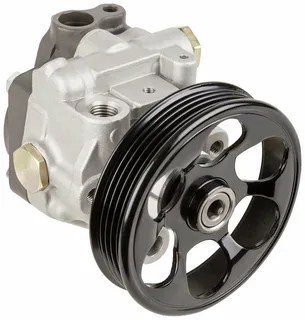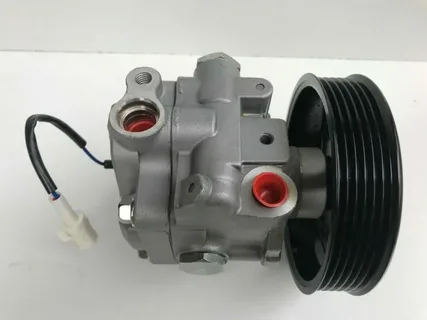Welcome to our comprehensive guide on the Forester Power Steering Pump. If you own a Forester or are looking to purchase one, understanding how the power steering system works and the importance of the pump is crucial. In this post, we will delve into everything you need to know about the Power Steering Pump, from its function and components to common issues and maintenance tips. So, buckle up and let’s dive into the world of Forester power steering.
Understanding the Subaru Impreza Power Steering Pump
The Subaru Impreza Power Steering Pump is a vital component of your vehicle’s power steering system. This pump is responsible for providing hydraulic assistance, making it easier to turn the steering wheel. Without it, you would have to use a lot more force to maneuver your vehicle.
The power steering pump works by using a belt connected to the engine to drive a hydraulic pump. This pump pressurizes the power steering fluid and sends it to the steering gear, which helps to steer the wheels. The pump also has a reservoir to store excess fluid and keep it cool.
Understanding how the Subaru Power Steering Pump works is important because it allows you to appreciate the benefits it provides. It not only makes steering easier but also enhances the overall driving experience.
In addition, being familiar with the power steering pump allows you to identify potential issues before they become major problems. By recognizing the symptoms of a failing pump, such as difficulty steering, strange noises, or fluid leaks, you can take prompt action to address the issue and prevent further damage.
Recognizing the Common Symptoms of a Failing Subaru Forester Power Steering Pump
As a responsible Forester owner, it’s crucial to be able to recognize the common symptoms of a failing Subaru Forester power steering pump. By identifying these signs early on, you can take prompt action and prevent further damage to your vehicle.
One of the most noticeable symptoms is difficulty steering. If you find it increasingly challenging to turn the steering wheel, especially at low speeds or when parking, it may be a sign of a failing power steering pump. You may feel resistance or a lack of responsiveness, making maneuvering your vehicle a struggle.
Another telltale sign is strange noises coming from the power steering system. If you hear whining, squealing, or groaning sounds when you turn the wheel, it’s likely due to a failing pump. These noises may indicate a lack of fluid or a malfunctioning pump component.
Fluid leaks are another indication of a failing power steering pump. Check for any visible leaks or puddles of power steering fluid underneath your Forester. Leaks can occur from worn-out seals or damaged hoses, and they should be addressed promptly to prevent further damage to the pump and the overall power steering system.
It’s important to note that these symptoms may also be present in other power steering system components, such as the steering rack or the hoses. However, if you notice any of these signs, it’s best to have a professional mechanic inspect your power steering pump to accurately diagnose the issue and recommend the appropriate repairs or replacements.
Maintaining Your Subaru WRX Power Steering Pump
Proper maintenance of your Subaru WRX power steering pump is crucial to ensure its longevity and optimal performance. By taking a few simple steps, you can keep your pump running smoothly and avoid potential issues down the road.
Regularly checking the power steering fluid level is the first step in maintaining your pump. Make sure the fluid is at the appropriate level and top it up if needed. Also, pay attention to the color and consistency of the fluid. If it appears dark or contaminated, it may be time to flush and replace the fluid.
Inspecting the power steering hoses for any signs of damage or leaks is another important maintenance task. Check for any cracks, bulges, or loose connections. If you notice any issues, have them repaired or replaced promptly to prevent further damage to your power steering pump.
In addition, it’s recommended to have your power steering system flushed and the fluid replaced at regular intervals, as specified in your vehicle’s owner’s manual. This helps remove any contaminants and ensures smooth operation of the pump.
Lastly, be sure to follow the recommended service schedule for your Subaru WRX, which includes regular maintenance of the power steering pump. This may involve tasks such as belt tension checks and inspections of pump components.
 DIY Repairs to Keep Your Pump Running Smoothly
DIY Repairs to Keep Your Pump Running Smoothly
Keeping your power steering pump in top shape doesn’t always require a trip to the mechanic. With some basic DIY repairs, you can keep your pump running smoothly and save some money in the process.
One common issue with power steering pumps is fluid leaks. If you notice any fluid pooling under your vehicle or see stains on the driveway, it’s time to take action. Start by identifying the source of the leak, which is usually a worn-out seal or a damaged hose. Depending on the extent of the damage, you may be able to fix it yourself by replacing the seal or hose. Just make sure to use the appropriate tools and follow the manufacturer’s instructions.
Another DIY repair you can tackle is belt replacement. Over time, the power steering pump belt can wear out or become loose, causing issues with pump performance. Check the belt regularly for any signs of wear or slackness. If you notice any issues, you can replace the belt yourself with the help of a few simple tools.
Additionally, flushing and replacing the power steering fluid can be done at home. This maintenance task helps remove any contaminants and ensures the smooth operation of the pump. Refer to your vehicle’s owner’s manual for the recommended fluid type and replacement interval.
Troubleshooting Issues with Your Subaru WRX STI Power Steering Pump
If you own a Subaru WRX STI, you know how important the Subaru WRX STI power steering pump is for smooth and responsive steering. However, like any other component, the power steering pump can develop issues over time. In this section, we will discuss some common troubleshooting tips for your Subaru STI power steering pump.
One common problem is a noisy power steering pump. If you hear whining or groaning sounds when you turn the steering wheel, it may be a sign of air trapped in the system or a failing pump. Bleeding the power steering system can help remove air pockets and restore proper operation. If the noise persists, it’s best to have a professional mechanic inspect the pump for any internal damage.
Another issue to watch out for is fluid leakage. If you notice any power steering fluid leaks under your vehicle, it’s crucial to address the problem promptly. Inspect the power steering hoses, connections, and seals for any signs of damage. Replacing worn-out seals or hoses can help prevent further leaks and maintain optimal pump performance.
Additionally, if you experience intermittent or inconsistent power steering assist, it may indicate a problem with the pump or the power steering control module. It’s recommended to have a qualified mechanic diagnose the issue using specialized diagnostic equipment and perform any necessary repairs or replacements.
Preventing Future Power Steering Pump Problems
Preventing future power steering pump problems is essential to ensure the longevity and optimal performance of your vehicle. By taking proactive measures, you can save yourself from costly repairs and maintain a smooth and responsive steering experience.
Firstly, regular maintenance is key. Stick to your vehicle’s recommended service schedule and have your power steering pump inspected at the specified intervals. This will help identify any potential issues before they become major problems. Additionally, don’t neglect the power steering fluid. Regularly check its level and quality, and replace it as needed. Dirty or contaminated fluid can lead to pump failure.
Next, be mindful of how you use your power steering. Avoid holding the steering wheel in a turned position for prolonged periods, as this can put unnecessary strain on the pump. Also, refrain from turning the wheel while the vehicle is stationary, as it adds stress to the pump and can cause damage.
Another important preventive measure is to be cautious when parking or driving in areas with rough terrain. Avoid hitting curbs or driving over large bumps, as these can cause damage to the power steering pump and its components.
Lastly, always address any power steering issues promptly. If you notice any symptoms of a failing pump, such as difficulty steering or fluid leaks, don’t hesitate to have it checked by a professional mechanic. Early detection and timely repairs can save you from extensive damage and costly repairs.
FAQS
Here are some frequently asked questions about the Power Steering Pump:
Q: How often should I check the power steering fluid level?
A: It is recommended to check the power steering fluid level regularly, ideally during every oil change or at least once a month. This ensures that the fluid is at the appropriate level and prevents any potential issues.
Q: What type of power steering fluid should I use for my Forester?
A: It’s crucial to use the correct type of power steering fluid recommended by Subaru for your Forester. Check your owner’s manual or consult a professional mechanic to determine the appropriate fluid for your specific model.
Q: Can I drive my Forester with a failing power steering pump?
A: While it may be possible to drive with a failing power steering pump, it is not recommended. It can make steering extremely difficult and compromise your safety on the road. It’s best to have the pump repaired or replaced as soon as possible.
Q: Can I replace the power steering pump myself?
A: While some DIY repairs are possible, replacing the power steering pump can be a complex task. It involves removing various components and can require specialized tools and knowledge. It’s recommended to consult a professional mechanic for pump replacements to ensure proper installation.
Q: How much does it cost to repair or replace a power steering pump?
A: The cost of repairing or replacing a power steering pump can vary depending on factors such as the specific model, labor costs, and whether it is a repair or replacement. It’s best to consult with a professional mechanic for an accurate cost estimate for your specific situation.
Q: How long does a power steering pump last?
A: The lifespan of a power steering pump can vary depending on various factors, including driving habits and maintenance. On average, a power steering pump can last anywhere from 75,000 to 150,000 miles. Regular maintenance and prompt repairs can help prolong its lifespan.
Remember, if you have any specific concerns or questions about your Power Steering Pump, it’s best to consult a professional mechanic for accurate advice and guidance.
Conclusion
In conclusion, the Power Steering Pump is a critical component of your vehicle’s power steering system. It plays a crucial role in making steering easier and enhancing the overall driving experience. By understanding how the power steering pump works and recognizing the common symptoms of a failing pump, you can take prompt action to address any issues and prevent further damage. If you encounter any issues with your Subaru power steering pump, it’s best to consult a professional mechanic for accurate diagnosis and repair. Addressing problems promptly can save you from costly repairs and ensure the reliability and performance of your vehicle.

